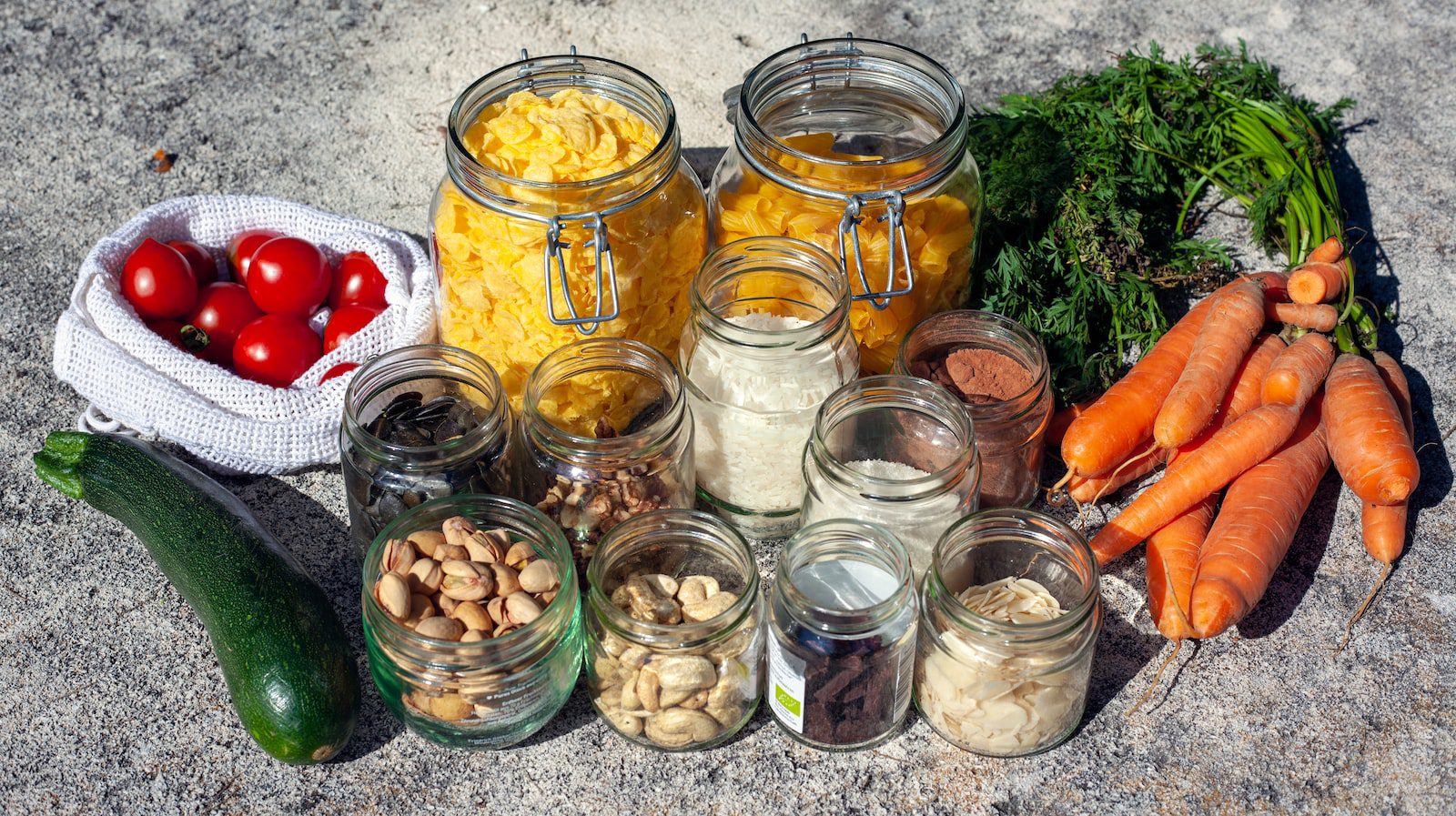Most of our food comes in some sort of packaging, which makes grocery shopping one of the most important areas in our lives to find zero waste alternatives. To make it easier, here is a comprehensive guide to help you plan your zero waste grocery shopping trip. The idea is to make shopping easier, more time efficient and most of all, more fun! This plan is based on shopping only once a week, which means we are going for maximum efficiency.
Step 1: Make a Meal Plan (See this post for ideas)
Those of you who are spontaneous chefs can skip this step and proceed directly to step 2 or even step 3! But for the rest of us, it helps to have an idea of what we are shopping for. Ask yourself the following questions: How many meals will I be cooking at home this week? Do I need to pack lunches? Do I have any special events (dinner parties etc.) coming up? Once you have an idea of how many meals you are shopping for, get a rough idea of the types of meals you will be making. No need to come up with elaborate five-course dinners, but having a rough idea about meals you’ll be cooking will help you save time (you won’t have to decide what to cook each night) and money (you won’t give in to impulse buys of food you don’t need). You’ll also improve your health; making a meal plan for the week can help you take control of your eating habits and get excited about cooking healthy meals.
While making your meal plan keep the following in mind:
Certain meals are difficult to make zero waste. Start with simple meals that don’t have too many complex ingredients and then work your way up to more complicated meals as you get accustomed to zero waste shopping and cooking.
Budget your time. Try not to plan your most complicated meal on the day you also have yoga class in the evening.
Be flexible. A meal plan is just a guide. If your co-workers want to go out for Taco Tuesday, go! Just remember to ask for your drink without a straw.
Don’t forget to include coffee, tea, snacks, etc. in your meal planning.
Try to include things you already have in your fridge in your meal plan to avoid food waste and save money.
*Low budget tip: Take a look at your income and food spending. Decide how much you’d like to spend on food per week (be sure to factor in eating out, coffees, etc). and take out that amount in cash at the beginning of the week. Cash makes it easier to control your budget than debit/credit cards.
Step 2: Make a Shopping List
Based on your meal plan, make a list of items you need for the upcoming week (be sure to use scrap paper or a note on your phone to avoid creating more waste). Check what you already have in your kitchen so you’re not buying double (decreases food waste and saves money). Since zero waste cosmetics and home remedies often include kitchen items, think about groceries you might need that aren’t included in your meal plan (baking soda for brushing your teeth, bananas for a face mask, olive oil for make-up remover, sugar for waxing, etc.).
*Low budget tip: Put your list into three categories: 1) Things you absolutely need for this week 2) Things that would be nice to have this week but could be purchased next week 3) Special treats. While you’re shopping, prioritize items in category 1, calculate how much you have left in your budget and then shop in categories 2 and 3 accordingly.
Step 3: Research Places to Shop
Since our goal is efficiency and fun, picking your shopping spots is of utmost importance so you don’t waste time running all over town. Connect with your Live Zero Waste mentor to see if they can put you in touch with zero-wasters in your area or post a question to our facebook to see if there have been any pledges in your country or city who can share their wisdom. You can also check out the bulk app for zero waste options in your area. If there are no locations yet, be a trailblazer! Add your favorite zero waste shopping spots and share the knowledge. That’s what the zero waste community is all about. In general, you should try to narrow down your shopping trip to two locations:
1) A farmer’s market or farm stand for fruits and veggies that come without packaging/stickers and eggs with returnable cartons.
2) A store with a bulk section, a bakery and a deli (such as a food co-op or health food store) for everything else. If you’re not able to consolidate to two locations, that’s ok, but this should be your long-term goal, since it will save you lots of time. Also prioritize geographical proximity, a bulk store that’s an hour from the farmer’s market will turn your shopping trip into an all-day event, which might be fun a couple of times but will be difficult on busy weeks.
Note: Many people nowadays opt for home delivery of groceries or CSA shares to save time. However, these options tend to include lots of packaging and plastic. If you want to use this type of service, be proactive! Some of our pledges have successfully requested to receive their deliveries packaging-free and even convinced the companies they order from to consider switching to plastic-free for everyone (see an example of how one of our pledges did this on social media here).
Step 4: Get your bags and containers ready
The main strategy with zero waste shopping containers is to use what you already have. There are many green products on the market, but if you’re trying to be as sustainable as possible, buying new should be a last resort. Plus, you shouldn’t have to break the bank to go zero waste.
One big bag or basket (a beach bag works well), plastic/paper bags you already have, bags friends already have, pillowcases, homemade cloth bags from old sheets etc. work well for bread, vegetables, grains and snacks. Check out ‘Tip Tuesday’ on our instagram for how to make cloth bags out of old t-shirts. For meat, cheese, nut butters, honey, oil etc you can use jars, but keep in mind that jars are very heavy so try to use jars only for things that will be messy in a bag. Get your glass jars and bottles from a thrift or from friends who don’t need them anymore, and don’t forget to bring an erasable marker, crayon or pen for marking the PLUs on your bags and jars.
Step 5: During Shopping
This is the fun part! Because you’ll be making lots of strange requests, zero waste shopping involves getting to know your farmer, grocer and baker on a much more personal level than you might be used to. It also involves being proactive. If you’re shopping at a grocery store, make sure you tare you jars (get the weight of the empty jar) and take a picture of the PLU # or write it on your bags/jar so you don’t have to use twisties. Make sure you watch the people ahead of you at the deli counter and bakery so you know what trash to avoid when you order. Explain clearly but respectfully to the seller what you’re trying to do and be sure to thank them profusely for their trouble. Also be ready to modify your shopping list on the fly. Can’t find what you’re looking for? This is your chance to be creative and think of alternatives that you can get zero waste. Take some notes about what containers your forgot and need to bring for next week. Consider buying something delicious and fun for your friends, co-workers or family, this makes having conversations about zero waste in your communities much easier!
*Low-budget tip: Buy more than you need of vegetables, fruits or berries that are cheap and in season and can or freeze them for later use (check out our food board on pinterest for tips).
When you’re unloading your groceries think about your meal plan and arrange your fridge accordingly. If you’re winging your meal plan put items that will go bad sooner towards the front and cook those first to maximize freshness and avoid food spoilage. As soon as you’re done with your bags, egg cartons, containers etc., put them inside your shopping bag in a designated spot. This will save lots of time the following week and you won’t have to scrounge around the house looking for your containers. If you know you’re going to have a busy week ahead, cook of couple of big meals over the weekend (a big pot of stew or a casserole) and freeze the leftovers for later.


Plato’s Closet is a great second hand store for the teens-30 age group (or older but I think especially for that younger age group) 869 West Eisenhower Pkway